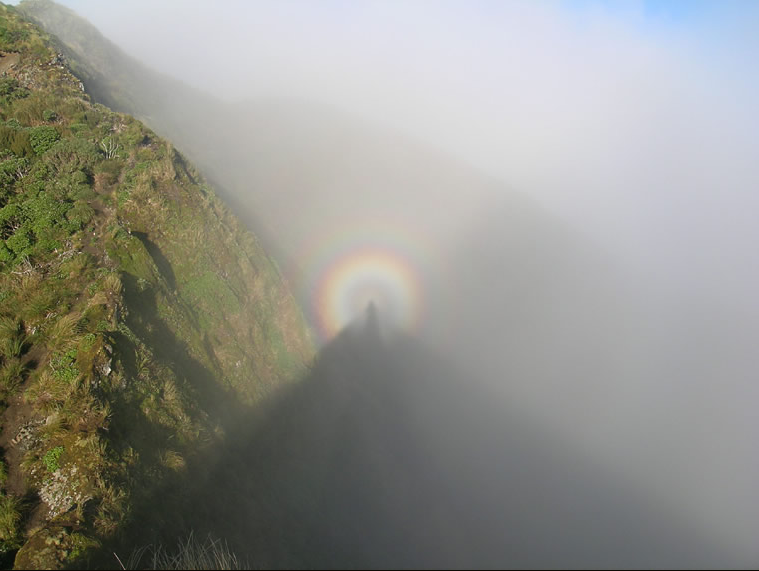Glory & Brocken Spectre
Glory & Brocken Spectre: A Phenomenon of Atmospheric Optics
Glory and Brocken Spectre are fascinating atmospheric optical phenomena that occur when sunlight interacts with mist or clouds. These mesmerizing spectacles have captured the attention of photographers and nature enthusiasts alike. In this article, we will delve into the intricacies of these phenomena and explore the science behind their formation.
The Enigmatic Glory
A glory is a multiringed optical phenomenon that appears directly opposite the sun. It materializes when sunlight penetrates through a thin layer of mist or cloud droplets. The mist droplets act as tiny prisms, diffracting the light and directing some of it back towards the source, creating a circular pattern of concentric rings.
While we can describe the formation of glories using Mie-Lorentz scattering theory derived from electromagnetic principles, the exact mechanism behind their occurrence still eludes us. This leaves us with a sense of wonder and curiosity, as we strive to unravel the intricacies of this ethereal phenomenon.
The Mystical Brocken Spectre
In contrast to the elusive nature of glories, the Brocken Spectre presents a more straightforward explanation. This phenomenon occurs when a person's shadow is cast onto a layer of mist or cloud. The shadow appears magnified and surrounded by a halo-like ring. The effect is enhanced when observed from an elevated position, such as a mountain peak or an aircraft.
The name "Brocken Spectre" originates from the Brocken, a mountain in Germany's Harz region where this optical illusion was first observed. The looming shadow projected through the mist creates a tunnel-like effect, giving rise to an awe-inspiring spectacle that has captivated observers throughout history.
Exploring the Glory Gallery
The Glory Gallery showcases a stunning array of images capturing the beauty and complexity of glories. These photographs offer a glimpse into the diverse manifestations of this atmospheric phenomenon. From vibrant rainbows encircling the sun to intricate concentric rings, each image tells a unique story of light interacting with mist or cloud droplets.
Photographers and scientists have utilized specialized tools like the Imaging and Radiation Image System (IRIS) to study and simulate glories accurately. This technological advancement allows us to explore the intricacies of these optical wonders, gaining a deeper understanding of their formation and characteristics.
Unraveling the Science
While the exact mechanisms behind the formation of glories and Brocken Spectres continue to perplex researchers, we can gain insight into their occurrence through the study of light diffraction and scattering. The interaction between sunlight and mist droplets plays a crucial role in shaping these atmospheric optical phenomena.
When sunlight encounters mist or cloud droplets, the droplets act as tiny prisms, refracting and diffracting the light. This diffraction causes the light waves to bend and scatter, creating the mesmerizing patterns observed in glories. The phenomenon is further enhanced by interference effects between the diffracted waves, resulting in the multiringed appearance.
A Symphony of Light and Mist
The interplay between light and mist in the formation of glories and Brocken Spectres exemplifies the captivating beauty of nature's harmonious symphony. These optical phenomena serve as a reminder of the intricate complexities present in our atmosphere. From the diffraction of light to the projection of shadows, they offer a glimpse into the wonders that surround us.
As we continue to unravel the secrets of atmospheric optics, glories and Brocken Spectres stand as captivating reminders of the mysteries that await our exploration. By delving deeper into their formation and characteristics, we can gain a profound appreciation for the enchanting interplay between light, mist, and our ever-changing atmosphere.
So next time you find yourself gazing at a glorious ring of light encircling the sun or witnessing the ethereal magnification of your own shadow amidst a sea of mist, take a moment to marvel at the intricate dance of nature's elements that gives rise to these mesmerizing spectacles.

Glory & Brocken Spectre Shadow imaged by John Saunders near Maungahuka Peak, Tararua Range, New Zealand on 25th April '08. ©John Saunders, shown with permission.
Multiringed glories directly opposite the sun are formed when the sun rays break through thin mist. Tiny mist droplets diffract the light and some is directed straight back sunwards.
That is all very well, but there is no simple explanation of just how this happens. Mie-Lorentz scattering theory derived without approximation from electromagnetic theory predicts glories excellently. You can do so yourself with IRIS. But that remains somehow unsatisfying because the 'how' is missing.
The Brocken Spectre, is altogether more simple. It is the long shadow of the photographer projecting tunnel-like through the mist.
Glory Gallery
Note: this article has been automatically converted from the old site and may not appear as intended. You can find the original article here.
Reference Atmospheric Optics
If you use any of the definitions, information, or data presented on Atmospheric Optics, please copy the link or reference below to properly credit us as the reference source. Thank you!
-
<a href="https://atoptics.co.uk/blog/glory-brocken-spectre/">Glory & Brocken Spectre</a>
-
"Glory & Brocken Spectre". Atmospheric Optics. Accessed on April 20, 2024. https://atoptics.co.uk/blog/glory-brocken-spectre/.
-
"Glory & Brocken Spectre". Atmospheric Optics, https://atoptics.co.uk/blog/glory-brocken-spectre/. Accessed 20 April, 2024
-
Glory & Brocken Spectre. Atmospheric Optics. Retrieved from https://atoptics.co.uk/blog/glory-brocken-spectre/.